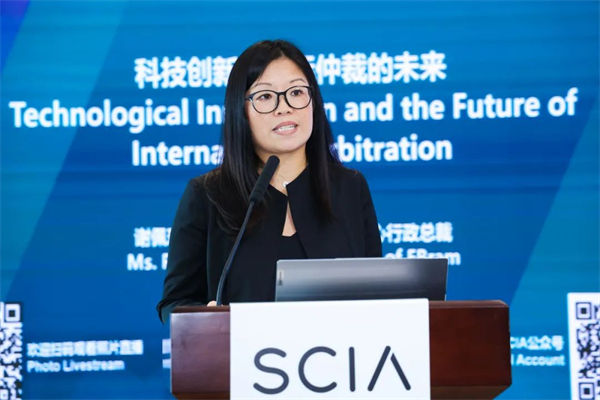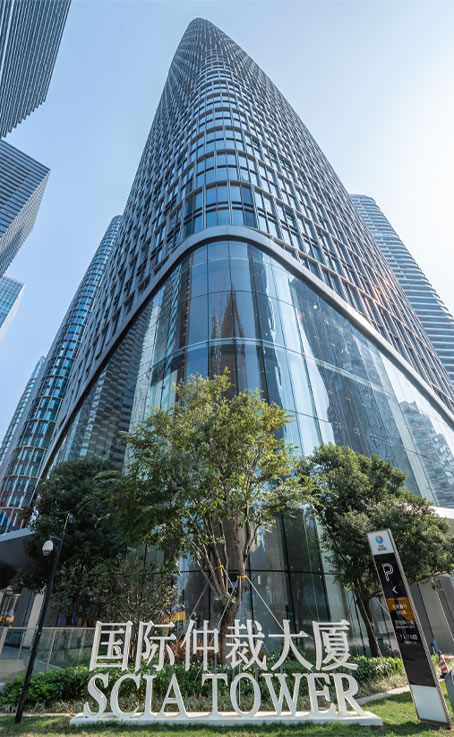

On 9 May 2024, the XXVIth Congress of International Council for Commercial Arbitration (ICCA 2024) Shenzhen Side Events were held at the Shenzhen Court of International Arbitration (SCIA) headquarters at SCIA Tower, Qianhai, Shenzhen. The ICCA 2024 Shenzhen Side Events were co-hosted by the SCIA and the South China International Arbitration Center (HK) (SCIA HK), together with Department of Justice of the Hong Kong SAR Government and HKIAC. Ms. Pui-Ki Emmanuelle Ta, CEO of eBram delivered a speech on “Technological Innovation and the Future of International Arbitration” during the event. Extracts of her speech are set out below.

It is with great pleasure that I join today’s discussion on “Technological Innovation and the Future of International Arbitration”. Before looking at the future, I wanted to first look at the past, but due to the time constraint, we will just skip the past and go straight to the future.
As you all know, stakeholders of international arbitration are still relatively slow in the adoption of technology in international arbitration, compared with many other non-legal industries. In other non-legal industries, technology can often be tied directly to profitability, and that is a great driver for the quick adoption of technology. However, in international arbitration, there are often more concerns, including concerns in relation to maintaining a degree of consistency despite the flexibility in procedure and maintaining accountability despite the consensual basis of arbitration. The rate of adoption of technological innovation in international arbitration is quite often the product of tension between adhering to existing conventions, which have a better track record of being tried and tested. The time and cost efficiencies are ultimately attributable to the parties and the convenience and accuracy that the lawyers and arbitrators can benefit from the use of the technology. I’m not proposing that the standards and conventions developed over decades for international arbitration be disregarded in favor of technological development. And despite the rapid development of generative AI for example, I do not propose that AI is in any position to replace arbitrators anytime soon.
Instead, I think it is important to be realistic about the state of technology that is available to us and how we can best apply that technology. It is about striking a balance between the factors that lead to the tension that I’ve just mentioned. It is also about using technology, not for the sake of using technology, but using it in a way that meets the needs of the arbitration users. For example, transcription is a very common feature used in arbitral hearings. A transcript is important because it keeps the record of the meeting and of what was said and can often be relied upon as evidence during cross-examination and when making closing submissions after the hearing.
However, transcription is also a pain point for many users of international arbitration. Not only because hiring a human transcriber is usually very expensive, but there are also logistical challenges to overcome, including having to seek and obtain quotations from transcription providers, obtaining approval on the use of the transcriber and agreeing with the counterparty on the engagement of such transcriber, and also checking the availability of the transcriber and also accounting for the fact that a transcriber is human after all, and will require frequent breaks and rotation of the transcribers. Also, if language interpretation is required during the hearing, that adds an additional layer of complexity to the issue as well; not only will the parties or the lawyers need to coordinate the transcriber and the interpreter, but we also need to engage a separate transcriber for each language to be transcribed. At the end of the hearing session, we will most likely need to arrange for the transcripts to be merged.
From my experience at eBRAM, aspects of artificial intelligence technology, specifically those that relate to machine learning and natural language processing, can be applied to mitigate these pain points. This includes the fact that machine transcription is available on demand 24/7 and that it works tirelessly without requiring breaks at inopportune times. The use of transcriptions also does not need to be restricted to hearings either due to the concern that transcribers would be expensive and not as readily available. With machine transcription, users can simply fire up the video conferencing system and turn on the transcription as they please during a case.
Machine transcription can also be combined with real-time translation. Instead of requiring multiple interpreters and multiple transcribers trained in transcribing different languages present at the hearing, the combination of the technologies offer a newer approach to multilingual transcription that previously was not possible, but for this technological advancement. This means that any hearings conducted and transcribed in English can also be translated at the same time into another language, for instance, English to Chinese or Chinese to English, or into other languages.
While the technology itself is important, the mode in which technology is offered and might be accepted by the market is also an important factor to consider in relation to any attempt to transform the legal landscape for the better. To maximize the technological benefits, eBRAM, for example, offers the machine transcription mentioned before, as part of its Online Dispute Resolution platform or what we call the ODR platform, which is itself complimentary to the institutional services provided by eBRAM.
eBRAM does not simply provide the technology, but it provides the support necessary to bring technology to life. After all, eBRAM is as much an arbitration and mediation institution providing institutional services as it is a company developing and providing LawTech solutions. When parties adopt the eBRAM rules for dispute resolution, including mediation and arbitration, the rules specify the use of the ODR platform, so, there is no need for the parties to separately agree and accept the use of the ODR platform and the machine transcription contained within it. There is no need for a lengthy negotiation process just to ensure the availability of transcription of hearing or procedural call. There will be, by default, a video conferencing transcription solution available for use once the case commences. This is a change in the practice of adoption of technology itself that we hope to offer through our institutional offering. This is unique to eBRAM and it is not something that can be achieved by pure technology, or by any singular technology provider alone.
The structure of the ODR platform is designed to cover the arbitration process from head to toe. As mentioned, it currently already covers video-conferencing capabilities, machine transcription and translation of the transcription which are useful for fully virtual, hybrid and even physical hearings. Additional technology incorporated onto the platform includes electronic know-your-client procedures for streamlined case commencement, tools for the management of case information and procedural timetable, secure cloud storage space for the exchange of documents, etc. And we also have electronic signing abilities that are combined with blockchain technology to make signed documents tamper-evident. Because the ODR platform covers the full arbitration process when there are new technologies that further complement arbitration procedures, there is room on the eBRAM ODR platform to allow new features to be incorporated under the same framework.
Looking forward, and as we see exciting new technologies constantly appearing on the horizon, eBRAM is also constantly evaluating the application of these technologies and considering whether they are a good fit for the needs of the arbitration community and good for facilitating the evolution of arbitration processes. In our view, there should always be a two-way dialogue, so while we are very excited to be providing technologies for use, we are also always on the lookout for feedback from our users and on what you hope to see for the future of arbitration.
Thank you very much.

